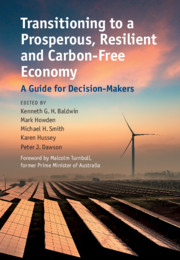Book contents
- Transitioning to a Prosperous, Resilient and Carbon-Free Economy
- Transitioning to a Prosperous, Resilient and Carbon-Free Economy
- Copyright page
- Dedication
- Contents
- Figures
- Tables
- Contributors
- Foreword
- Introduction
- 1 Policy Frameworks and Institutions for Decarbonisation: The Energy Sector as ‘Litmus Test’
- Technologies for Decarbonising the Electricity Sector
- Example Economies
- Cities and Industry
- 11 Cities
- 12 Buildings and Precincts
- 13 Urban Water
- 14 National Climate Change Adaptation Case Study: Early Adaptation to Climate Change through Climate-Compatible Development and Adaptation Pathways
- 15 Transport
- 16 Industry and Manufacturing
- Land Use, Forests and Agriculture
- Mining, Metals, Oil and Gas
- Addressing Barriers io Change
- Index
- References
15 - Transport
from Cities and Industry
Published online by Cambridge University Press: 08 October 2021
- Transitioning to a Prosperous, Resilient and Carbon-Free Economy
- Transitioning to a Prosperous, Resilient and Carbon-Free Economy
- Copyright page
- Dedication
- Contents
- Figures
- Tables
- Contributors
- Foreword
- Introduction
- 1 Policy Frameworks and Institutions for Decarbonisation: The Energy Sector as ‘Litmus Test’
- Technologies for Decarbonising the Electricity Sector
- Example Economies
- Cities and Industry
- 11 Cities
- 12 Buildings and Precincts
- 13 Urban Water
- 14 National Climate Change Adaptation Case Study: Early Adaptation to Climate Change through Climate-Compatible Development and Adaptation Pathways
- 15 Transport
- 16 Industry and Manufacturing
- Land Use, Forests and Agriculture
- Mining, Metals, Oil and Gas
- Addressing Barriers io Change
- Index
- References
Summary
Transport contributes around 11% of greenhouse gas emissions and the sector is also vulnerable to climate change. High temperatures can melt roads and distort rail lines while sea-level rise can disrupt coastal transport infrasructure. At the community level, cities and precincts can help mitigate climate change and adapt to changes by promoting active lifestyles with walking and bicyling replacing powered transport for short-distance travel and making cities more compact. Significant cost and health benefits can accrue from reduction of diseases associated with low physical activity and air pollution can also be mitigated. Increased provision and electrification of public transport based on renewable energy can decarbonise these services. The electification of sea and air transport present challenges but significant development work is underway with expected early availability of electrically powered short-haul aircraft. Phase-out of internal combustion engine cars and other vehicles is scheduled in several countries as battery-electric and hydrogen cars, buses and heavy transport vehicles emerge. Governments can help the transition with a range of policy initiatives.
- Type
- Chapter
- Information
- Transitioning to a Prosperous, Resilient and Carbon-Free EconomyA Guide for Decision-Makers, pp. 389 - 407Publisher: Cambridge University PressPrint publication year: 2021



